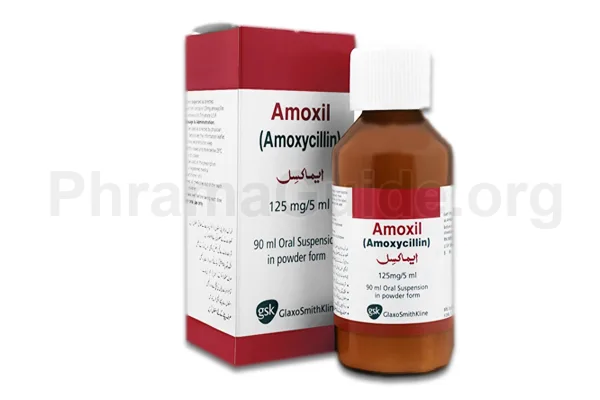Amoxil is an antibiotic medication belonging to the class of drugs known as penicillins. Amoxil syrup is primarily used to treat a wide variety of bacterial infections in children and adults where a low dose of medicine is needed. The following are some common uses and indications of Amoxil Syrup:
- Respiratory Tract Infections: The use of Amoxil syrup is effective in treating infections of the respiratory tract, such as bronchitis, pneumonia, sinusitis, and tonsillitis.
- Ear Infections: Amoxil syrup can be used to treat bacterial infections of the middle ear, known as acute otitis media.
- Urinary Tract Infections: It is commonly used for urinary tract infections (UTIs) caused by susceptible bacteria.
- Skin and Soft Tissue Infections: Amoxil syrup may be used to treat skin infections, such as cellulitis, impetigo, and infected wounds.
- Dental Infections: Amoxil syrup can be used for dental infections, including abscesses and gum infections.
- Gastrointestinal Infections: Amoxil syrup also can be used to treat certain bacterial infections in the gastrointestinal tract, such as bacterial gastroenteritis.
Off-label Uses of Amoxil Syrup
- Lyme Disease: Amoxil syrup may be used off-label for the treatment of Lyme disease in certain cases. However, the use of other antibiotics such as doxycycline or amoxicillin with probenecid is generally preferred.
- Helicobacter pylori Infection: In combination with other medications, Amoxil syrup may be used for the treatment of Helicobacter pylori infection, which is associated with peptic ulcers and gastritis.
- Prophylaxis for Endocarditis: In some cases, Amoxil syrup may be used as prophylaxis against bacterial endocarditis, particularly before dental procedures or surgeries in individuals with certain heart conditions.
- Lyme Disease Prophylaxis: Amoxil syrup may be used off-label as prophylaxis for Lyme disease in individuals who have been bitten by a tick and are at risk of developing the infection. However, other antibiotics such as doxycycline are typically preferred.

What is Amoxil?
Amoxil Syrup is one of the leading brands of Amoxicillin in oral liquid form, manufactured and marketed by GlaxoSmithKline (GSK).
Amoxil Alternatives : Amoxicillin Other Brands
The following are some alternative brands of Amoxil Syrup and their manufacturers.
- Supramox : Bosch Pharmaceuticals (Pvt) Ltd, Pakistan.
- Amoxicap : Don Valley Pharmaceuticals (Pvt) Ltd, Pakistan.
- Maxil : Macter International (Pvt) Ltd, Pakistan.
- Zoxicillin : Zafa Pharmaceutical Laboratories (Pvt) Ltd, Pakistan.
- Adamox : Adamjee Pharmaceuticals (Pvt) Ltd, Pakistan.
- Amocillin : (CCL) Consolidated Chemical Laboratories (Pvt) Ltd, Pakistan.
- Amoxascot : Scotmann Pharmaceuticals, Pakistan.
- Arpimox : Sanofi Aventis (Pakistan) Ltd.
- Blomox : Bloom Pharmaceuticals (Pvt) Ltd, Pakistan.
- Effimox : Wilsons Pharmaceuticals, Pakistan.
Amoxil : Available Formulations and Strengths
Presentl, Amoxil is available in Syrup, Capsules, Drops, and Injection forms.
Amoxil Syrup is available in 2 strengths:
- 125mg/5ml
- 250mg/5ml
Amoxil Capsules: 250mg and 500mg strengths.
Amoxil Drops: 125mg/1.25ml strength.
Amoxil Injections: 250mg and 500mg strengths.
Who Should Not Use Amoxil?
Amoxil syrup has certain contraindications, which are specific situations or conditions in which Amoxil should not be used due to potential risks.
- Allergic Reaction: Amoxil syrup should not be used in individuals who have a known allergy or hypersensitivity to amoxicillin or any other penicillin antibiotics. Allergic reactions can range from mild skin rashes to severe and potentially life-threatening reactions.
- Severe Liver Dysfunction: Individuals with severe liver dysfunction or a history of liver damage should avoid Amoxil syrup. The medication is primarily eliminated from the body through the liver, and impaired liver function may affect its metabolism and clearance.
- Infectious Mononucleosis: Amoxil syrup is contraindicated in individuals with infectious mononucleosis (also known as mono or glandular fever). The use of amoxicillin in these cases can cause a skin rash called an “ampicillin or amoxicillin rash,” which is typically not an allergic reaction but a characteristic of the viral infection.
- Previous Severe Amoxicillin-Associated Diarrhea: If an individual has experienced severe, potentially life-threatening diarrhea (such as pseudomembranous colitis) associated with previous amoxicillin use or antibiotic-associated colitis, Amoxil syrup should be avoided.
Recommended Daily Dosage of Amoxil Syrup
Amoxil Syrup Dose for Pediatric Patients:
- Infants (up to 3 months): 30 mg/kg/day divided into two or three doses.
- Children (over 3 months and up to 40 kg):25 mg/kg/day divided into two or three doses.
- Children (over 40 kg): 250-500 mg every 8 hours or 500-875 mg every 12 hours.
Amoxil Syrup Dose for Adults:
- 250-500 mg every 8 hours or 500-875 mg every 12 hours, depending on the severity of the infection.
How Amoxil Works?
Amoxil is a penicillin-type antibiotic that works by stopping the growth of bacteria. It does this by binding to penicillin-binding proteins (PBPs), which are essential for the synthesis of bacterial cell walls. When Amoxil binds to PBPs, it prevents the cross-linking of peptidoglycan, a major component of bacterial cell walls. This weakens the cell wall and makes it more susceptible to rupture, eventually leading to the death of the bacteria.

Leave A Comment